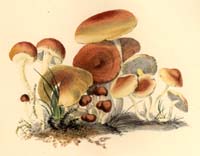Coprinus comatus
 Key to Gilled Mushrooms Key
Key to Gilled Mushrooms KeyThis is a key to gilled mushrooms, that is, mushrooms having a definite cap with a fertile surface consisting of gills. The fruiting body usually also has a stem, although that may be lateral or absent (usually, then, the mushroom is growing from wood). You can use this key to identify mushrooms that you find.
 Agaricales Order
Agaricales OrderFruiting body containing fibers (usually in the stalk)
 Black Spored Suborder
Black Spored SuborderSpore print black, very dark brown, purplish black, or dark purplish brown, but not fitting the Gomphidiaceae
Gills usually light grey, becoming black from spores only when very mature
 Coprinus Genus
Coprinus GenusAll deliquescing fungi go here
All striate or pleated-capped non-Gomphidius black-spored mushrooms go here (but not randomly wrinkled ones: they go in Psathyrella)
When young, the cap usually cylindrical, and in any case much taller than it is wide and hugging the stem tightly; the gills at this stage are white, and packed very close together
Cap usually deliquescing and surviving in age as uplifted tatters or split fragments
Cap often covered with powder or tiny hairs, especially when young
 Large Shaggy Scaly Inky Section
Large Shaggy Scaly Inky SectionCap up to 6" high; white, silvery, or some light greyish brown color; covered with fibrillose shags or scabby-looking white to brownish patches of universal veil material
Coprinus comatus (O. F. Müller: Fries) S. F. Gray
Here are the characters that distinguish this species from the others in its group. For its more general characters, see higher up on the page.
If there's just a few words or a microscopic feature here, a more thorough description can be found above.

Diagnosis
- Cap up to 6" high; white at first, with conspicuous fibrillose tufts; turning pinkish in a zone in between the blackening/deliquescing margin and the pristine white cap tissue
-
Annulus present
-
Stalk hollow, with a tough thread that runs the length of the interior
Microscropic Characters






 Key to Gilled Mushrooms Key
Key to Gilled Mushrooms Key Agaricales Order
Agaricales Order Black Spored Suborder
Black Spored Suborder Coprinus Genus
Coprinus Genus




